It was Hippocrates that said, “Walking is the best medicine.” More than two millennia later, the Greek physician’s assertion still rings true.
Never mind 10,000, according to a recent study, increasing your daily step count from 2,700 to just 4,400 was found to significantly reduce risk of death.
But making any steps, let alone more, can get riskier as we get older.
“As we age, the number one concern is fall risk. A lot of that fall risk is because we start to lose the connection and the sensation in the feet,” says Dr. Emily Splichal, a functional podiatrist in New York City.
She points out that nerve sensitivity in the bottom of the feet peaks at age 40 and studies show that by 70, we need twice as much information coming in to create the same response.
Splichal calls that information “noise” and she designed Naboso textured insoles to increase that noise.

“So, we’re turning the volume up to that noise so [people] can actually reconnect and now they feel more confident when they walk. They feel more stable when they’re standing in their shoes.”
Aside from age-related sensitivity loss, Splichal says the Neuro Insoles, in particular, can help with diabetic neuropathy as well as with neurological conditions; they are being studied for potential to improve stride, speed and gait for people with Multiple Sclerosis and Parkinson’s disease.
So how do the insoles work?

Small pyramid shaped bumps, at just the right height and just the right distance from each other, stimulate specific nerves in the foot to boost messaging to the brain.
“Some people call it coffee for their brain,” Splichal says.
The extra stimulation helps increase the amount and speed of information between the feet and the brain — and the response to changes underfoot.
“You can’t think, “Oh, correct myself before I fall over the curb.’ It has to be happening subconsciously,” Splichal explains. “We give this undertone of noise to the nervous system and to the brain [and] now they’re going to be able to react faster. It makes the process much more efficient — especially as we age.”
The insoles are thin, washable and non-toxic. Naboso translates to “barefoot” in Czech and Splichal says the benefit is best when the insoles are worn without socks — or placed in your sock — as it maximizes skin-to-surface contact.
And on the subject of best practices, Splichal notes that hard soles transfer information better. And, although cushioning in our footwear may feel nice, she warns against too much of it.
“When we strike the ground, we feel vibrations. But cushion takes that vibration. If you cannot feel vibration, you will not be able to maintain balance, transfer energy — your nervous system becomes a little bit slower.”
For more information and to purchase, visit nabosotechnology.com.
